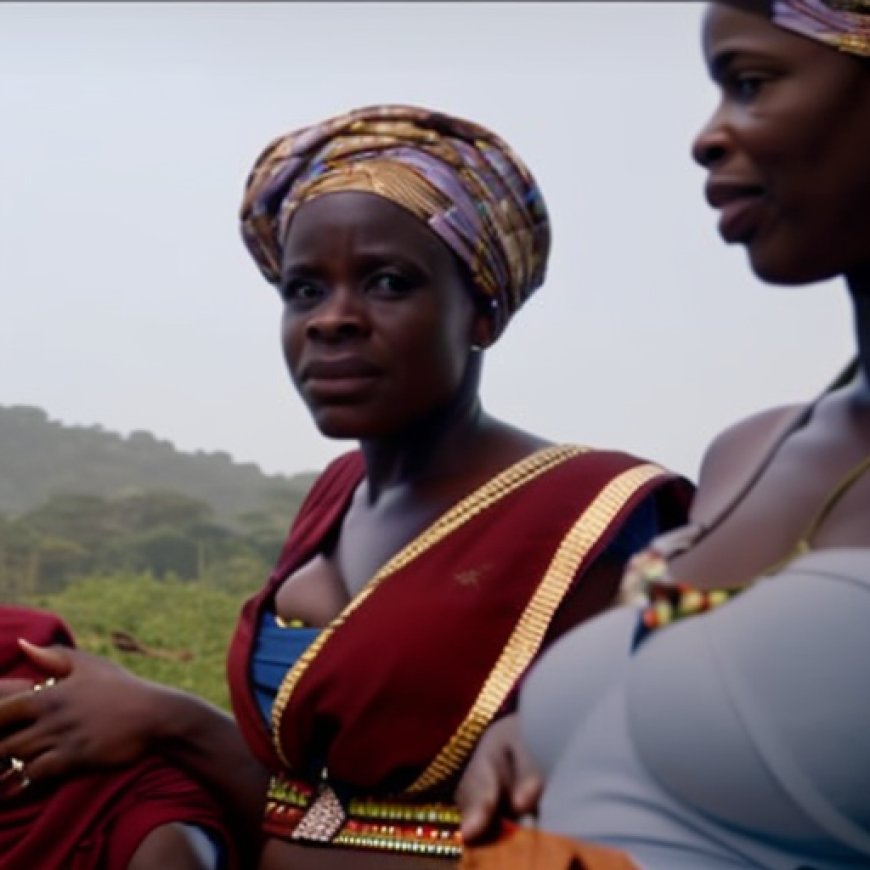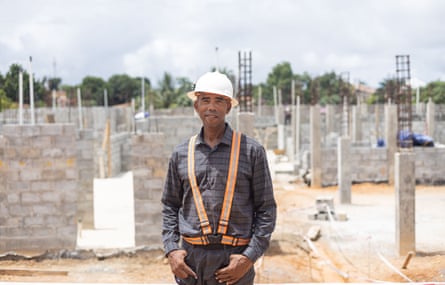‘It is for us, who will give birth here’: the women breaking barriers to build Sierra Leone’s new maternity unit
‘It is for us, who will give birth here’: the women breaking barriers to build Sierra Leone’s new maternity unit The Guardian


In Kono District, Sierra Leone, Women Help Build Maternal Center of Excellence
In Kono District, in the Eastern Province of Sierra Leone, where diamond-rich earth was once exploited to fund a decade-long civil war, a new legacy is being built in its capital, Koidu.
Behind a steel fence, the rooms of a new maternity centre, the Maternal Center of Excellence, are emerging – and about 60% of those wearing hard hats on site are women. Most are working in construction for the first time and are conscious they are helping to build the region’s future. “It is for us, the women who will give birth here. That’s why we are putting in effort to build the hospital,” says Hawa Baryoh, 21, who works in quality control. “That is why you see plenty of women here,” she says proudly.
Improving Maternal Healthcare in Sierra Leone
The building will serve the Koidu government hospital next door, and promises a change for the region and country, which in 2019 had one of the highest rates globally for maternal mortality with a healthcare system blighted by civil war and Ebola, which killed 7% of its healthcare workers. Despite an improvement in maternal deaths from 1,165 per 100,000 live births in 2013 to 717 per 100,000 in 2019, the rate remains high.

A walk around the noisy site reveals women involved in every inch of the work, from welding and bricklaying to carrying heavy head pans. Until last year, Baryoh was earning five to 10 leones a day (20p to 40p) selling corn on the street. Now, as the breadwinner for her family, she is helping to train other women on the site.

The 166-bed facility, which is due to partly open by the end of next year, is funded through a public-private partnership by the international nonprofit Partners in Health and the Sierra Leone government.
John Chew, the site supervisor from Build Health International, the nonprofit construction partner on the project, is part of the team working even through the rainy season. Many of the women on site credit him with providing a safe space to work and encouraging them to expand their skills. News that women were treated well and fairly spread through word of mouth in Kono and more and more women came seeking employment until they made up most of the workforce. “I’m very proud of them,” says Chew. “We build this for tomorrow and to train others.”
Baryoh says she hopes the project will give other women courage to work there, too: “What men can do, women can do.”
Improving Maternal Healthcare in Kono District
Isata Dumbuya, the director of reproductive, maternal, neonatal and adolescent health at Partners in Health Sierra Leone, was born in Kono but has spent a large part of her life in the UK where she trained in the NHS as a midwife. She returned about five years ago and has set her sights on improving the region’s maternal healthcare. “I still had ties here and I kept hearing that it had the worst maternal mortality rate in the world. You feel a sense of wanting to do something about this, we’ve been hearing this for far too long,” she says.
Dumbuya says part of her work has been changing mindsets so that death in childbirth is not accepted as normal. “If you are used to seeing people die from preventable things, even when people do die, you don’t see the grief,” she says. “[I would say] I need you to be angry and to be passionate and I need to do everything in my reach to ensure it doesn’t happen again.

“The first year I was here, there was one week where we had seven people die and I nearly lost my mind.”
Dumbuya originally envisaged staying for 18 months but hope has kept her in Kono. “You keep on seeing the results, even the little things,” she says. “That keeps you going, and every year when you hear the reduction in maternal mortality rates you think, collectively, if we keep on going, we can make this happen.”
Improved Facilities and Services
In the blue and cream maternity unit of Koidu government hospital – which will eventually transfer its maternity services and special care baby unit to the new center – Dumbuya greets the nurses, midwives, and patients with a hug or a joke. Since 2015, the hospital has benefited from improved facilities, with the help of Partners in Health – its maternity unit now has 24-hour electricity to provide caesarean sections. Every month they hold community blood drives where they encourage pregnant women to identify family members or friends who can donate blood.
“No
SDGs, Targets, and Indicators Analysis:
1. Which SDGs are addressed or connected to the issues highlighted in the article?
- SDG 3: Good Health and Well-being
- SDG 5: Gender Equality
- SDG 8: Decent Work and Economic Growth
- SDG 10: Reduced Inequalities
- SDG 17: Partnerships for the Goals
The article discusses the construction of a new maternity center in Koidu, Sierra Leone, which aims to improve maternal healthcare and reduce maternal mortality rates. This aligns with SDG 3, which focuses on ensuring healthy lives and promoting well-being for all at all ages. The involvement of women in the construction work highlights the importance of gender equality (SDG 5) and decent work and economic growth (SDG 8). The partnership between the international nonprofit Partners in Health and the Sierra Leone government demonstrates the commitment to partnerships for achieving sustainable development (SDG 17).
2. What specific targets under those SDGs can be identified based on the article’s content?
- Target 3.1: By 2030, reduce the global maternal mortality ratio to less than 70 per 100,000 live births.
- Target 5.5: Ensure women’s full and effective participation and equal opportunities for leadership at all levels of decision-making in political, economic, and public life.
- Target 8.5: By 2030, achieve full and productive employment and decent work for all women and men, including for young people and persons with disabilities, and equal pay for work of equal value.
- Target 10.2: By 2030, empower and promote the social, economic, and political inclusion of all, irrespective of age, sex, disability, race, ethnicity, origin, religion, or economic or other status.
Based on the article’s content, the specific targets that can be identified are related to reducing maternal mortality (Target 3.1), promoting women’s participation and equal opportunities (Target 5.5), achieving decent work for women (Target 8.5), and promoting social and economic inclusion (Target 10.2).
3. Are there any indicators mentioned or implied in the article that can be used to measure progress towards the identified targets?
- Maternal mortality rate (per 100,000 live births)
- Percentage of women involved in construction work
- Number of family-planning visits
- Rate of facility-based maternal deaths
- Rate of stillbirths
The article mentions the maternal mortality rate in Sierra Leone and the goal to reduce it. This serves as an indicator to measure progress towards Target 3.1. The involvement of women in construction work can be used as an indicator to measure progress towards Target 5.5 and Target 8.5. The article also mentions the goals for the new maternity center, including a five-fold increase in family-planning visits and a reduction in the rate of facility-based maternal deaths and stillbirths. These serve as indicators to measure progress towards the identified targets.
SDGs, Targets, and Indicators Table:
| SDGs | Targets | Indicators |
|---|---|---|
| SDG 3: Good Health and Well-being | Target 3.1: By 2030, reduce the global maternal mortality ratio to less than 70 per 100,000 live births. | Maternal mortality rate (per 100,000 live births) |
| SDG 5: Gender Equality | Target 5.5: Ensure women’s full and effective participation and equal opportunities for leadership at all levels of decision-making in political, economic, and public life. | Percentage of women involved in construction work |
| SDG 8: Decent Work and Economic Growth | Target 8.5: By 2030, achieve full and productive employment and decent work for all women and men, including for young people and persons with disabilities, and equal pay for work of equal value. | Percentage of women involved in construction work |
| SDG 10: Reduced Inequalities | Target 10.2: By 2030, empower and promote the social, economic, and political inclusion of all, irrespective of age, sex, disability, race, ethnicity, origin, religion, or economic or other status. | Number of family-planning visits |
Note: The indicators mentioned in the article are not exhaustive and additional indicators may be required to comprehensively measure progress towards the identified targets.
Behold! This splendid article springs forth from the wellspring of knowledge, shaped by a wondrous proprietary AI technology that delved into a vast ocean of data, illuminating the path towards the Sustainable Development Goals. Remember that all rights are reserved by SDG Investors LLC, empowering us to champion progress together.
Source: theguardian.com

Join us, as fellow seekers of change, on a transformative journey at https://sdgtalks.ai/welcome, where you can become a member and actively contribute to shaping a brighter future.







